レポート

All companies need to grow profitably in order to succeed. But only 11% of companies manage to grow profits and revenues by 5.5% or more over a 10-year period, and earn back their cost of capital. That’s a sobering statistic for company leaders, directors, employees and investors.
This report, based in part on Bain & Company’s 18-year longitudinal study of sustained value creators, two global surveys of senior executives and extensive interviews, addresses the following questions:
- What are the primary barriers and challenges that companies face today in their pursuit of sustained and profitable growth? How does this vary across stages of their life cycles?
- What distinguishes the companies that are able to anticipate and address these challenges most successfully from those that fail to achieve their goals?
- Are successful companies set up internally in a fundamentally different way, which allows them to react to challenges and adapt to opportunities better and faster than those that fall short? Do these differences trace back to the founding of the company and its deep fundamentals?
- Why is it that companies seem to mature at such different rates? Some stay flexible, open minded and innovative, and are excellent at attracting and retaining young talent; yet, others slow down, descend into bureaucracies, fall behind the innovation curve, and have difficulty attracting and holding talent.
- How can leaders use these insights to address the predictable crises of growth or to renew their organizations?
Key findings
Eighty-five percent of the executives we surveyed, and a full 94% of those running companies with more than $5 billion in revenue, said that internal obstacles, not external ones, keep their companies from growing profitably. Only a small percentage blamed external factors, such as unfairly advantaged competitors, government regulations and subsidies, inaccessible technologies and market conditions that did not offer growth opportunities.
The primary internal barriers to growth cited by executives included revenues growing faster than talent, increasing distance from the customer with growth, complexity of decision making slowing the company down, inability to choose focus and direction, and difficulty mobilizing resources. All of these challenges increase with company size and complexity, and we refer to this as the “paradox of growth”: Growth creates complexity, and complexity is the silent killer of profitable growth.
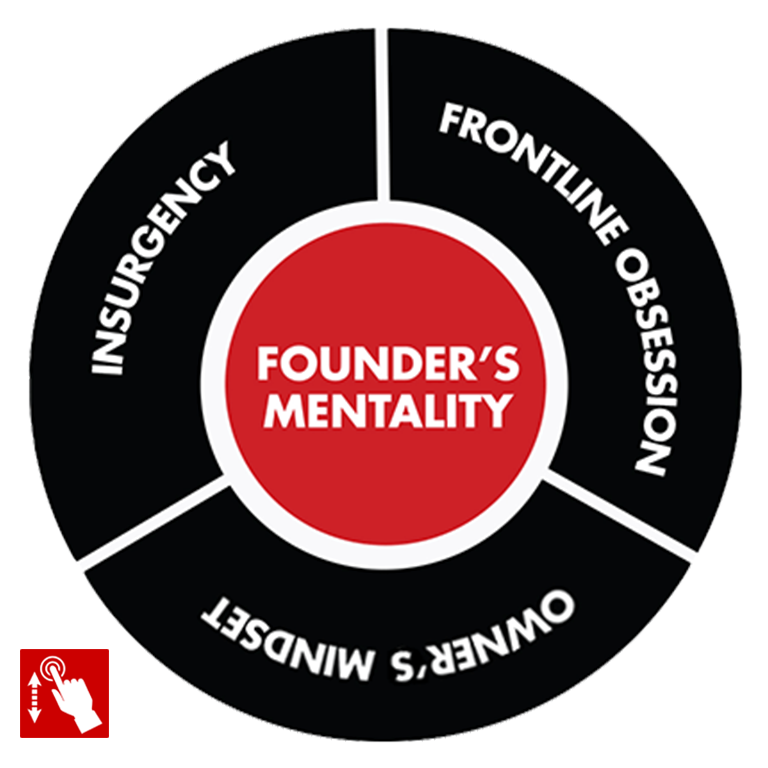
The Founder's Mentality Survey
How real is the distinction between scale insurgent and struggling bureaucracy? Explore by the numbers.
About 80% of the major swings in market value for companies occur as a result of decisions made and actions taken during three types of predictable crises that companies encounter (sometimes multiple times) during the course of their life cycle. These are the crises of overload, which typically occurs during a rapid scale-up period (five to ten times); stall-out, when the growth engine in a mature company loses momentum; and free fall, when a company’s business model no longer works and performance declines sharply.
- Two out of three large companies (worth $5 billion or more) will stall out, go bankrupt, be acquired or break into pieces in the next 15 years. Only one in seven recover their past momentum. Stall-out happens fast and is hard to reverse.
- About 5% to 7% of companies are in free fall or about to tip into it at any one time; of those, only 10% to 15% will recover and redefine their business models successfully.
The Founder’s Mentality defined
Many of the companies that surmount these challenges of growth and demonstrate higher levels of business and financial performance have maintained attitudes and behaviors most commonly found in young companies run by strong, successful founders. These attitudes and behaviors are specific and observable. We call them the “Founder’s Mentality.” Companies that maintain these traits as they grow tend to move and adapt faster, be more open-minded, and anticipate and adapt to the future better than those that lose the Founder’s Mentality as they age.
- Since 1990, returns to shareholders in public companies where the founder is still involved are three times higher than in other companies.
- Companies that are in the top 20% in terms of performance, regardless of whether they are still founder-led or not, are four or five times more likely to exhibit the attributes of the Founder’s Mentality than the bottom 20%.
Through our research, we have identified three primary traits of the Founder’s Mentality:
- The first is a sense of insurgent mission, characterized by a sense of higher purpose, a long-term horizon, and a few spikes in capabilities and assets that make a company special and are the centerpiece of its business model.
- The second is an obsession with the front line, characterized by an intellectual curiosity about every detail of the customer experience and of how everything in the business works. Executives use instincts formed at the ground level to make every decision; frontline employees are empowered and are the heroes of the business; and the customer voice is central to all decisions.
- The third is an owner’s mindset, characterized by a powerful sense of responsibility for employees, customers, products and decisions; an antipathy to bureaucracy; and a bias toward speed in decisions and actions.
The Founder’s Mentality tends to decline as companies grow in scale and become more mature. Layers form, increasing distance from leaders to the front line. Customer and employee loyalty and engagement tend to decline. Speed of decision making declines with size. We have identified eight forces that erode the Founder’s Mentality and the advantages of size as companies scale. We call these forces the westward winds and the southward winds. They are defined in more detail in our study.
By contrast, cultivating these three traits—the insurgent mission, the frontline obsession and the owner’s mindset—helps companies overcome the crises of growth. It puts them on the path to what we call scale insurgency, a state in which companies have grown to scale and achieved a position of leadership while maintaining the many benefits of the Founder’s Mentality. Scale insurgents represent more than 50% of net value created in the stock market. These companies, about 7% of the total, achieve both scale and high levels of the Founder’s Mentality at the same time.
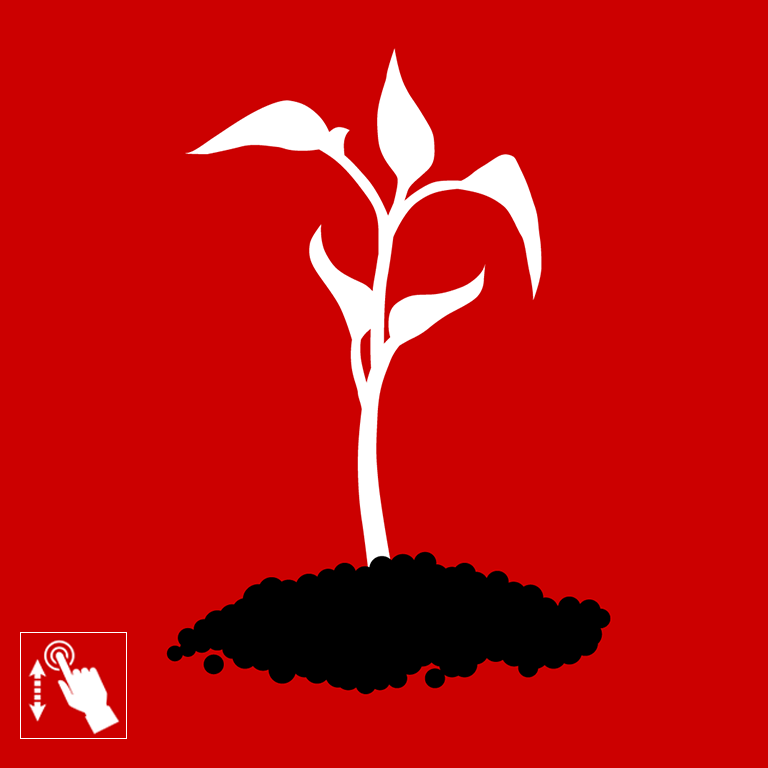
Inside the Founder's Mentality
Explore how companies that nurture and maintain three key traits are more likely to sustain growth.
1. The growth paradox
- Only 11% of companies are “sustained value creators”—companies that manage to achieve more than a modest level of profitable growth while earning their cost of capital over the course of a decade.
- 85% of executives surveyed cited internal barriers, not external barriers, as the primary obstacles to growth.
- The biggest internal barriers are the problems created when revenue grows faster than talent (55%); the loss of a sense of higher mission (43%); and the sluggishness and bureaucratic rigidity that accompany size and complexity.
- Leaders of 56 companies in developing markets cited two major causes leading to internal barriers: the problems that accompany size and complexity (71%) and revenues growing faster than talent (63%).
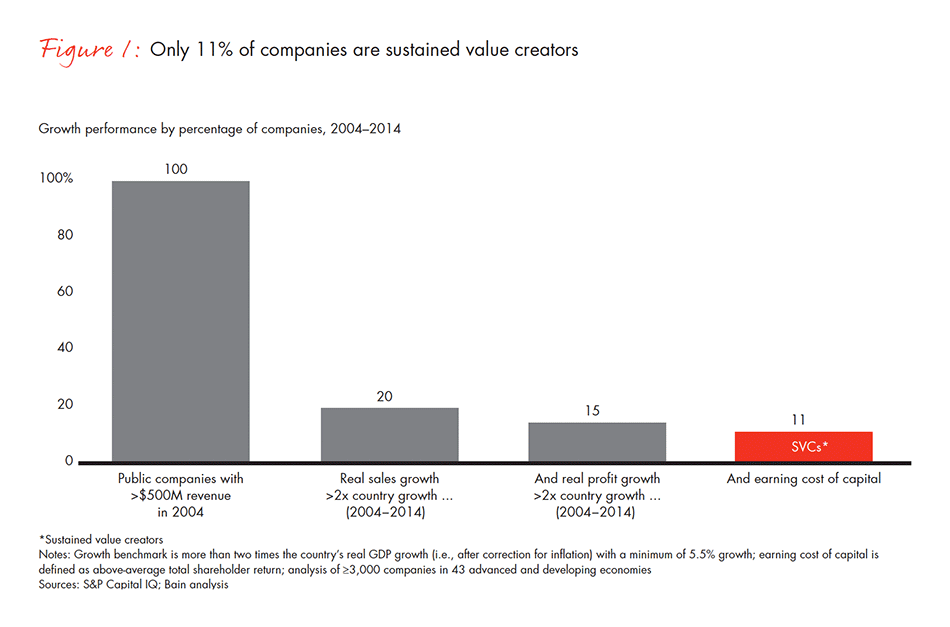
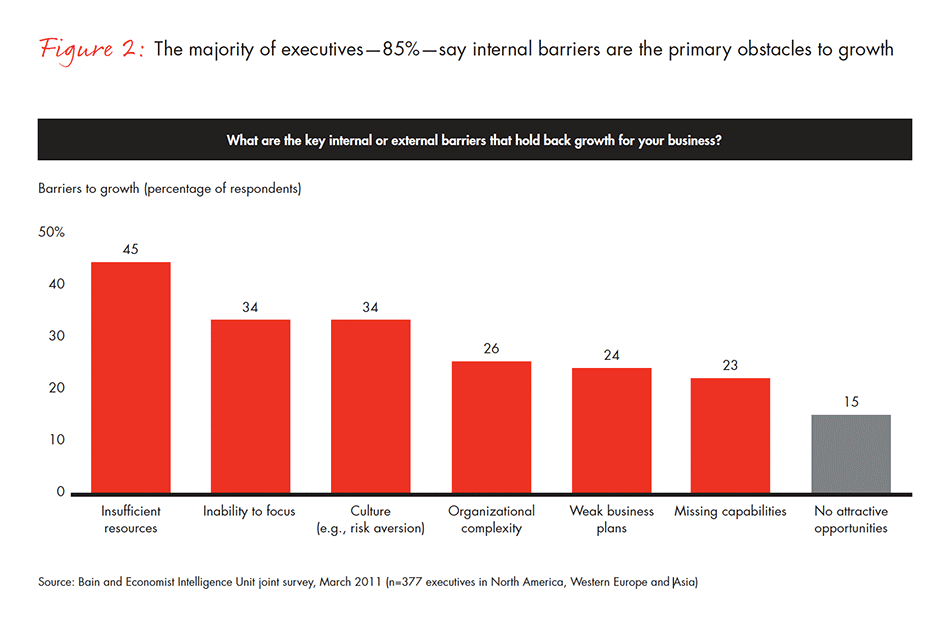
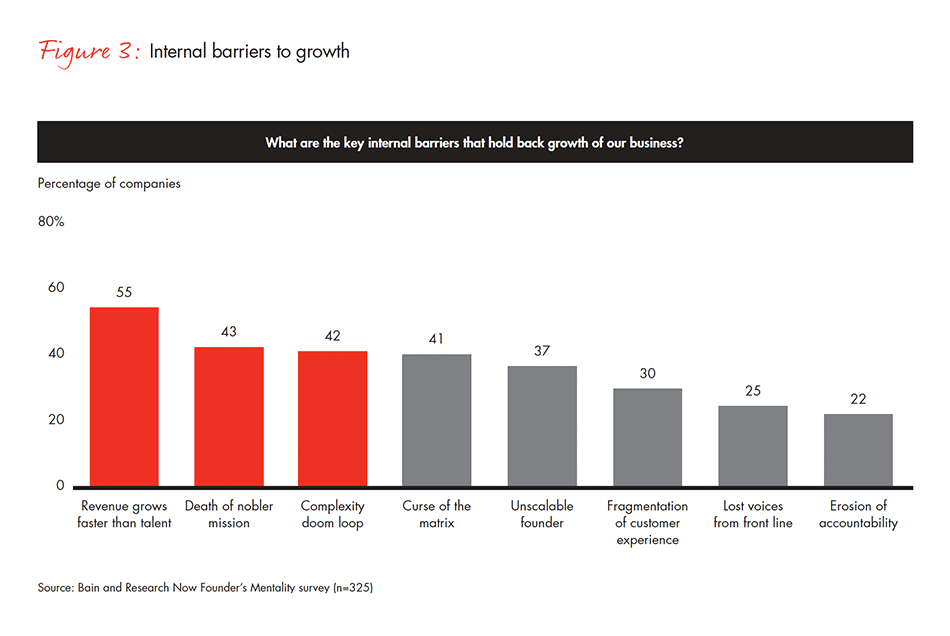
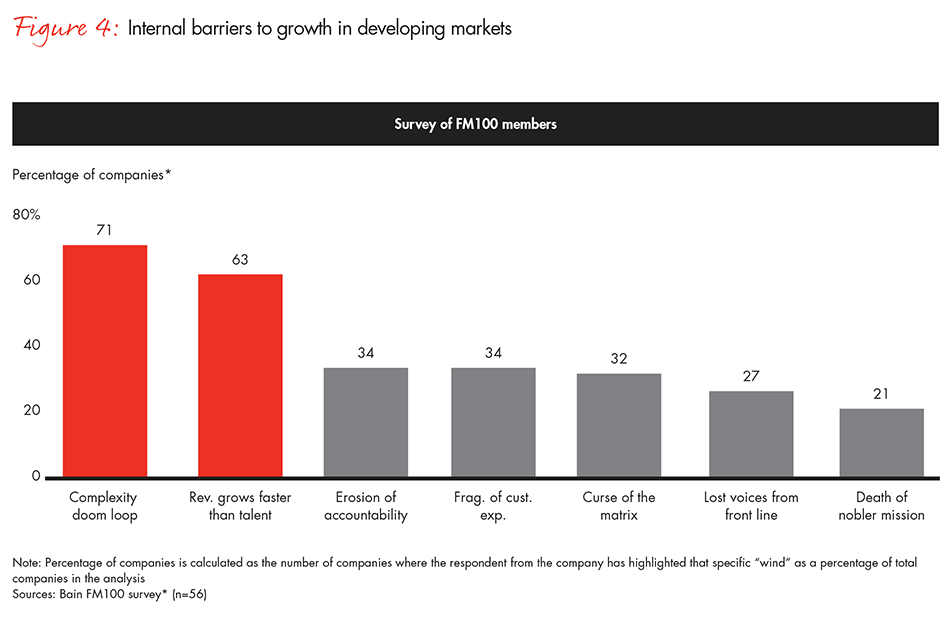
2. The Founder’s Mentality
- Most companies that achieve sustainable growth are run with “the Founder’s Mentality”—a set of motivating attitudes and behaviors that can usually be traced back to a bold, ambitious founder.
- Since 1990, founder-led companies have consistently outperformed other S&P 500 companies. From 1990 to 2014, they performed 3.1 times better.
- Even when we exclude tech companies, founder-led companies outperformed other S&P 500 companies by 1.8 times from 1990 to 2014.
- The most sustainably profitable companies exhibit the characteristics of the Founder’s Mentality four to five times as often as lower performers.
- 93% of entrepreneurs surveyed consider the Founder’s Mentality a huge competitive advantage.
- As confirmed by surveys, the Founder’s Mentality consists of three main traits: a sense of insurgent mission, an obsession with the front line and an owner’s mindset.
- Executives perceive a significant decline in the Founder’s Mentality with size. The Founder’s Mentality score drops dramatically from companies with revenues of $500 million or less (72.3/100) to companies with revenues of $5 billion or more (56.1/100).
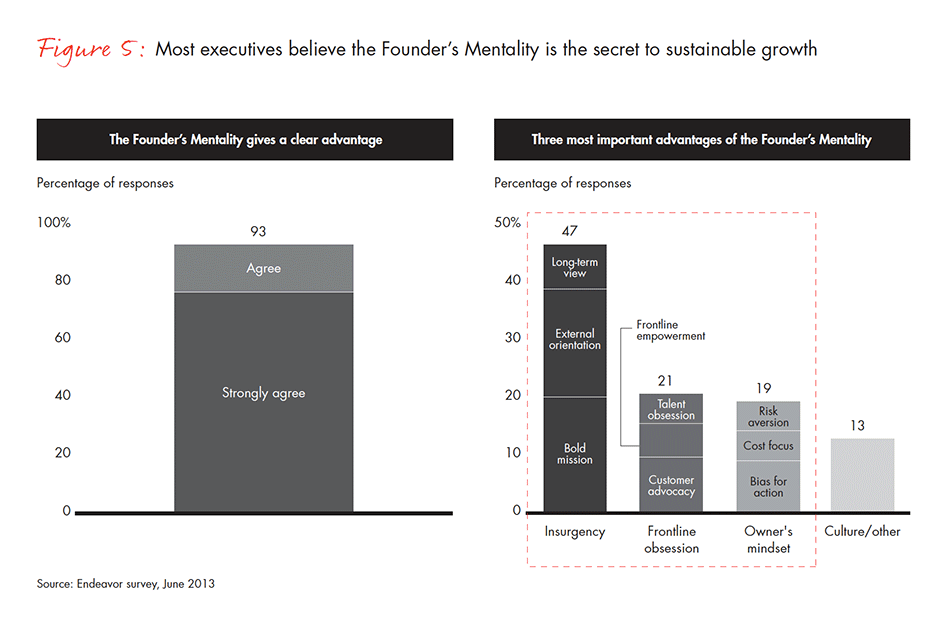
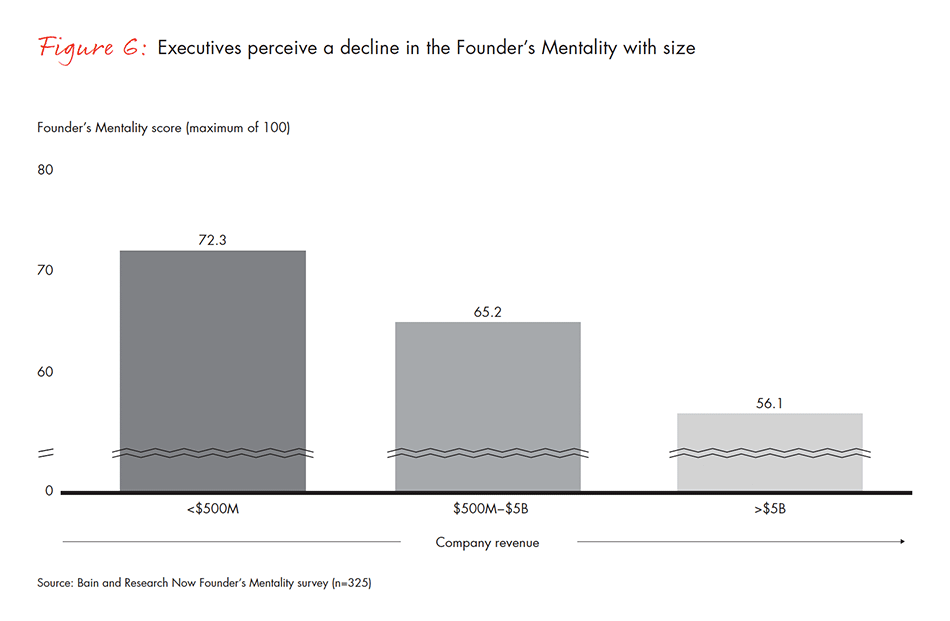
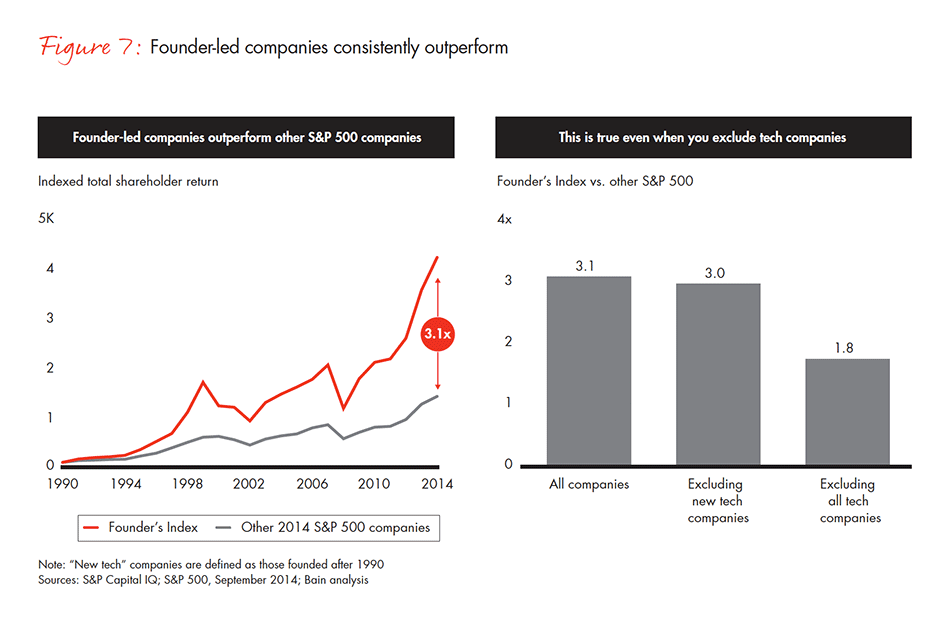
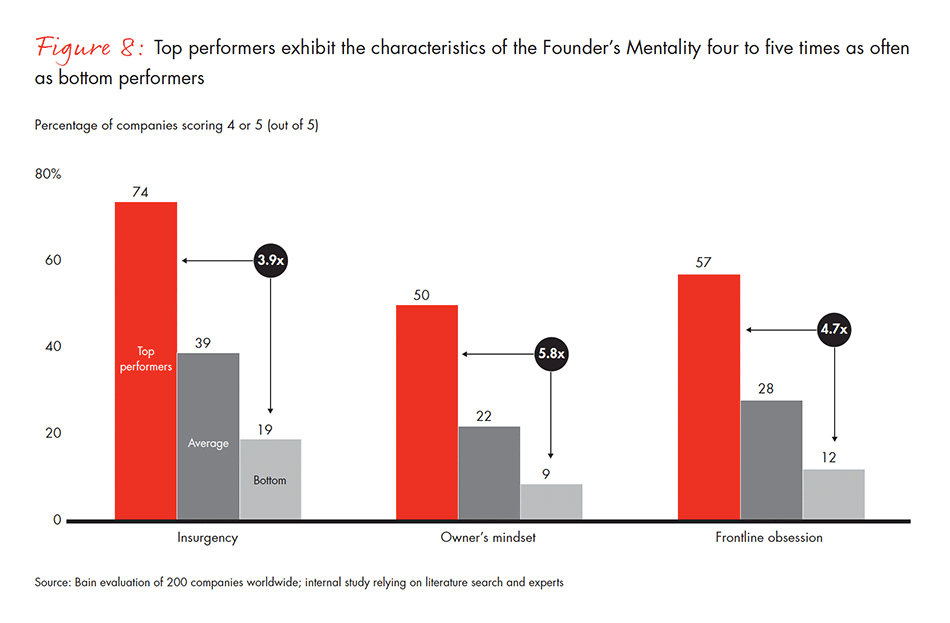
3. The crises of growth
- About 80% of the swings in value for companies occur during or as a result of decisions made in one of three crisis periods: overload (the crisis of youth), stall-out (the crisis of incumbency) and free fall (the crisis of late maturity). Focusing on the Founder’s Mentality helps companies survive all three.
- Only one in 17,000 companies will grow to $500 million and become a sustained value creator because of the bottlenecks, systems breakdowns and complexity that accompany growth and lead to overload.
- Executives surveyed cite a series of predictable forces that contribute to overload that include revenue growing faster than talent (55%), an unscalable founder (37%), lost voices from the front line (25%) and the erosion of accountability (22%).
- As companies scale, the Founder’s Mentality becomes difficult to preserve: Executives surveyed report that senior management loses external focus, spends less time directly with customers and has trouble with personalized talent management.
- Unlike in the past, large companies have a hard time sustaining growth and creating value for shareholders.
- When stall-out hits, it can be sudden and drastic. The 50 companies with the biggest market-cap declines in 2007 – 13 had an average growth rate of 12% in the 5 years before stall-out, compared with a rate of – 1% in the 5 years during stall-out.
- About a third of the 1998 Fortune 500 companies stalled out, and a third were acquired or went bankrupt. Of those that stalled out, only 10% to 15% recovered.
- Executives report that four key forces create stall-out: the death of the nobler mission (43%), unchecked complexity that kills growth (42%), bureaucratization (41%) and the fragmentation of customer experience (30%).
- 80% of those that recovered from stall-out did so by returning to their core business, and 20% by redefining the whole business model.
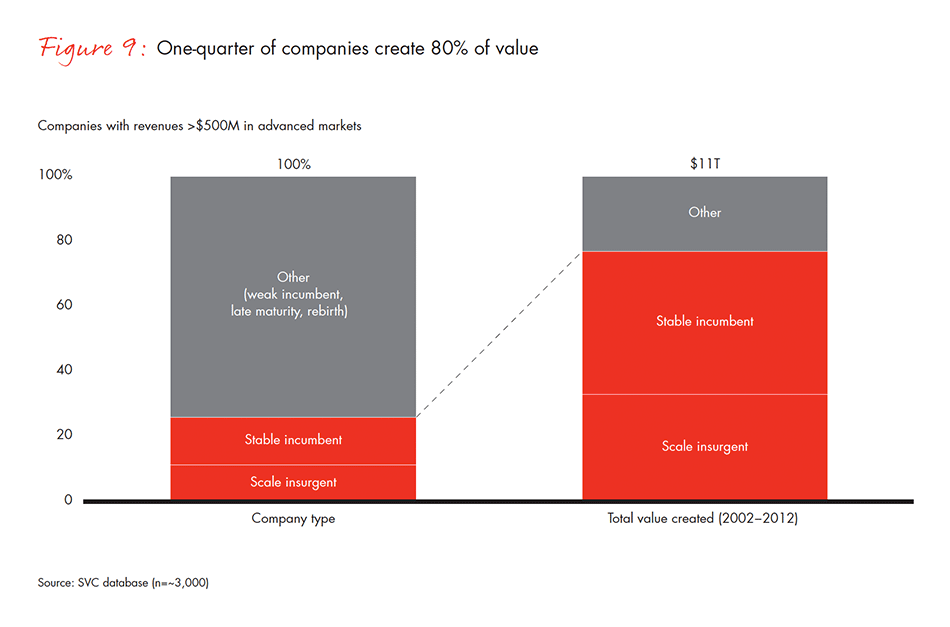
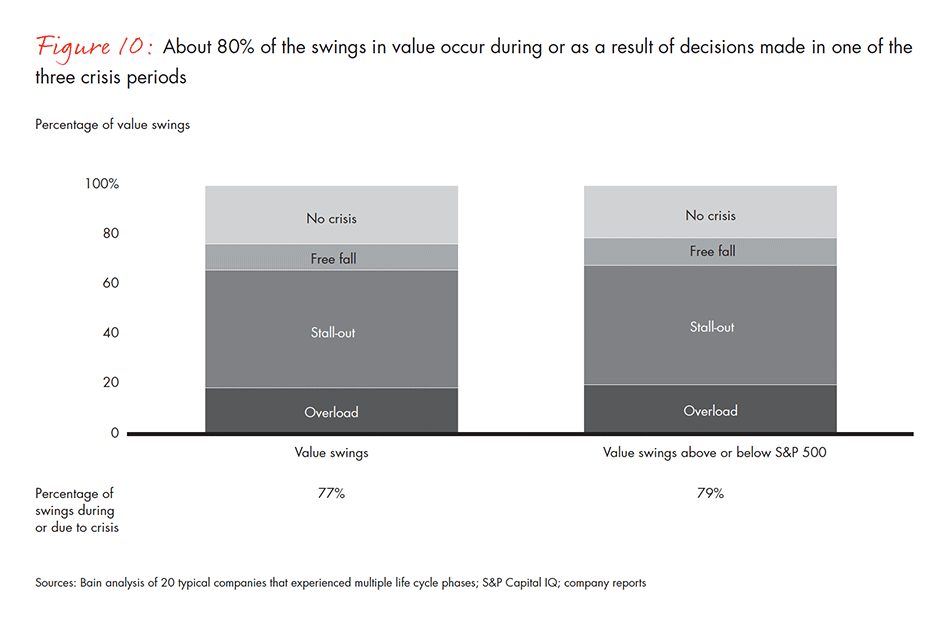
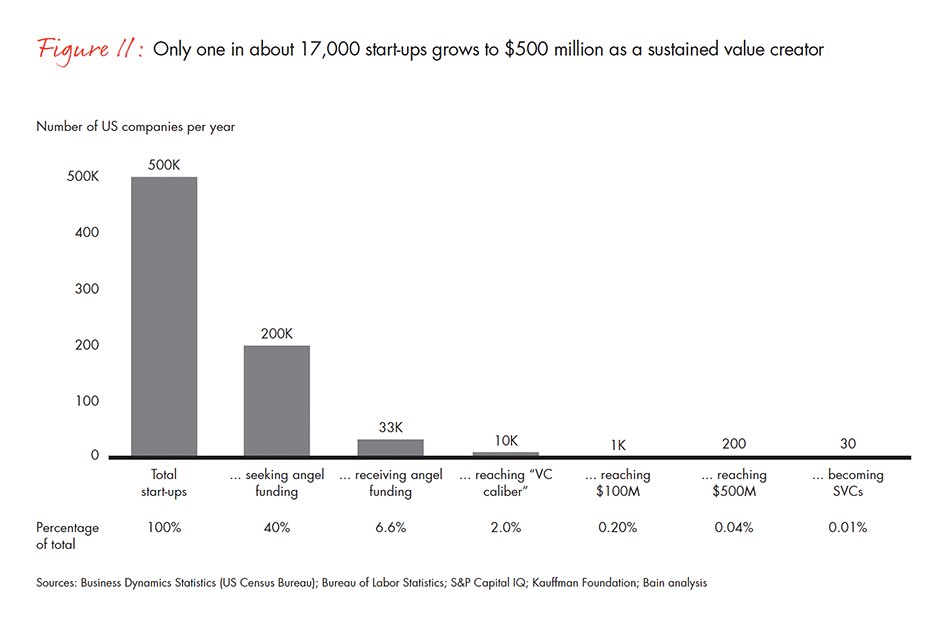
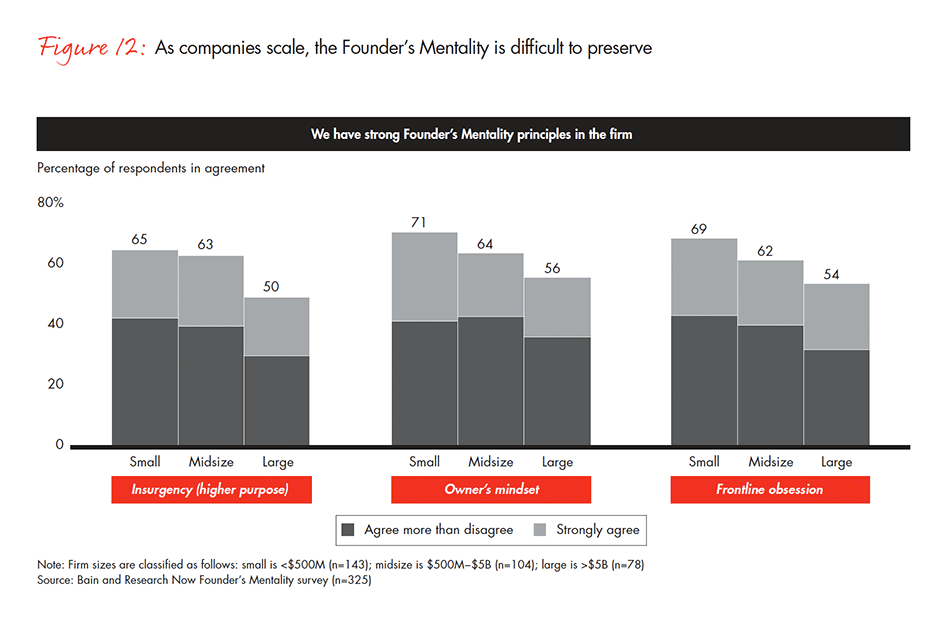
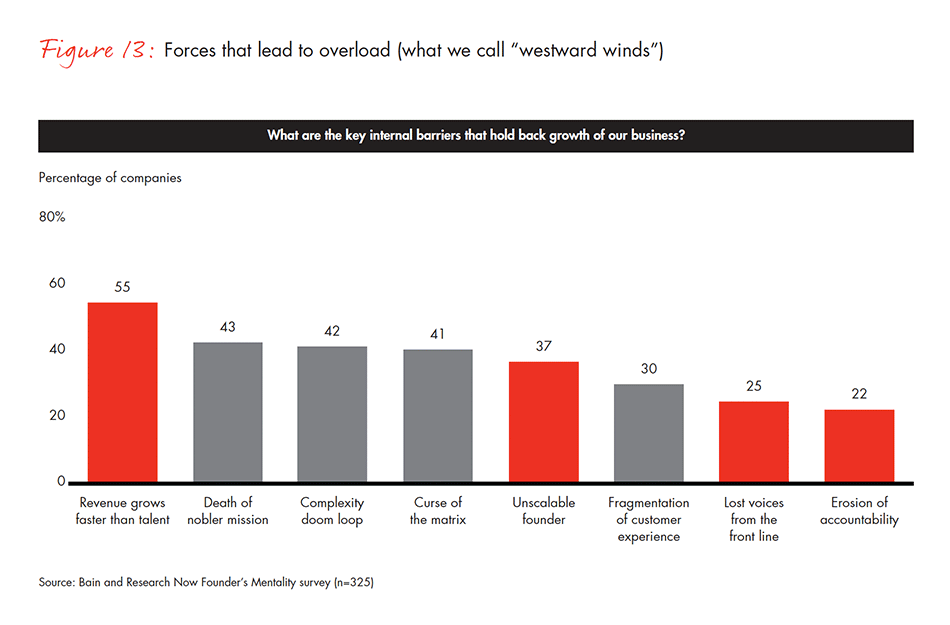
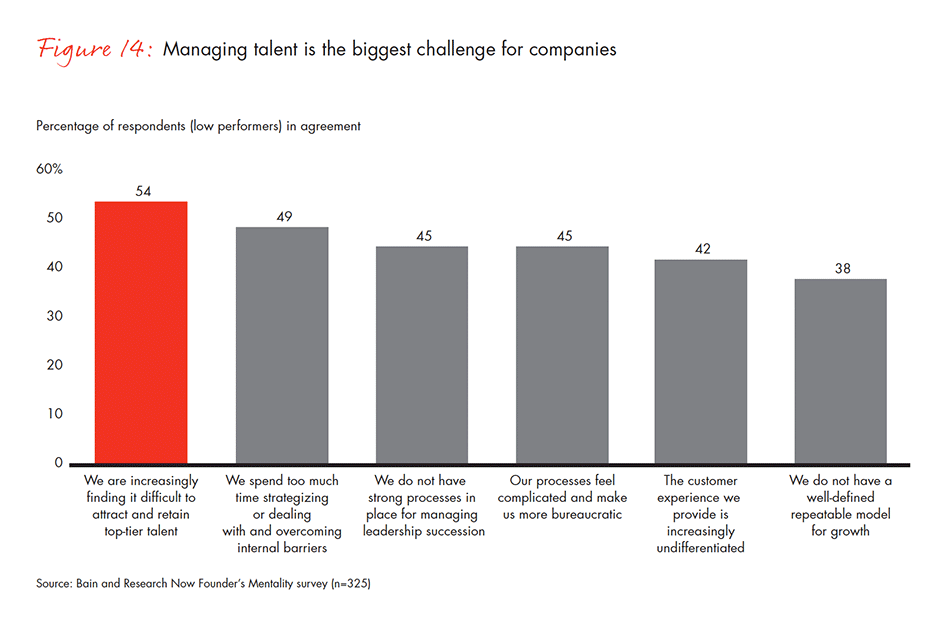
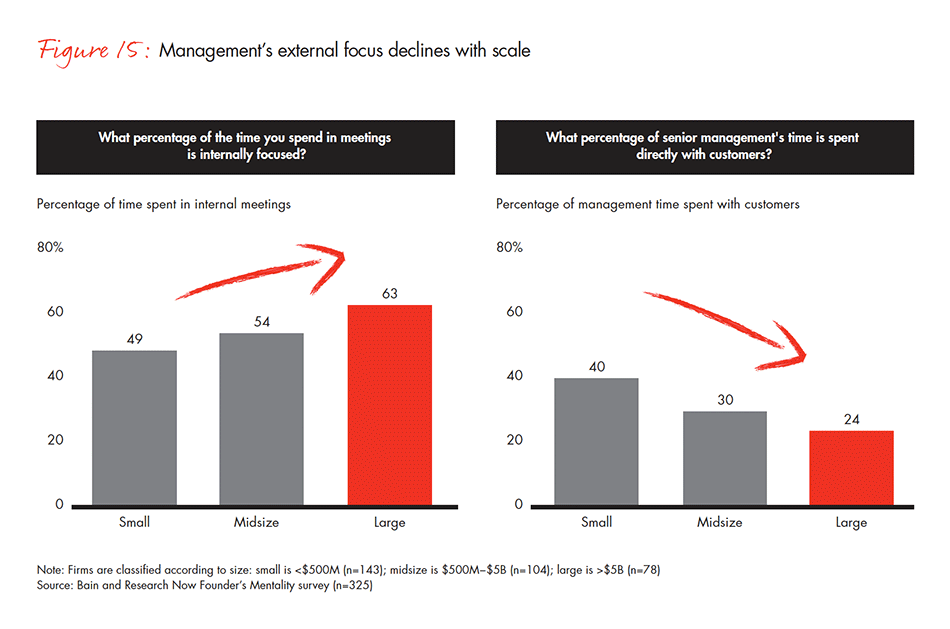
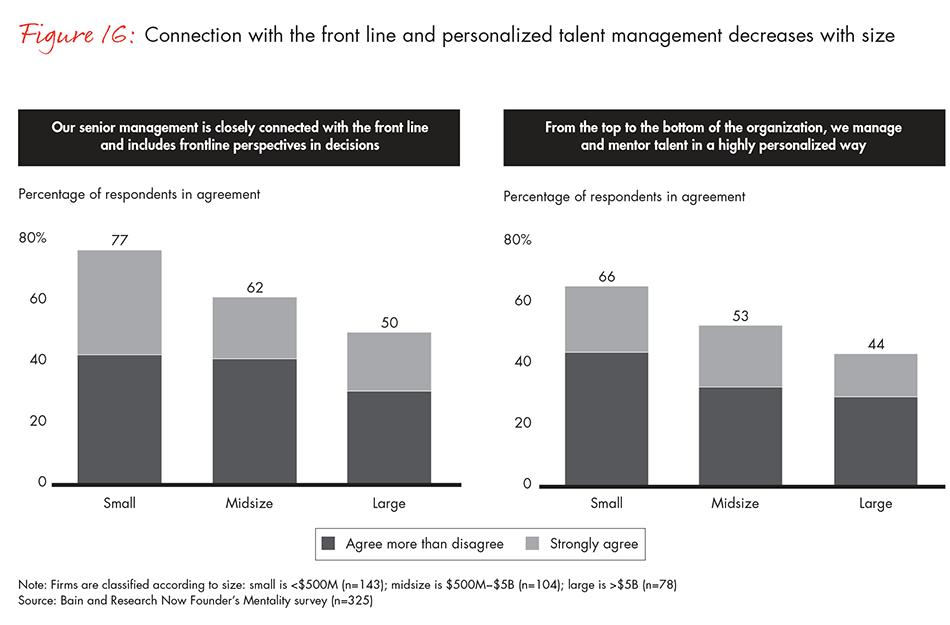
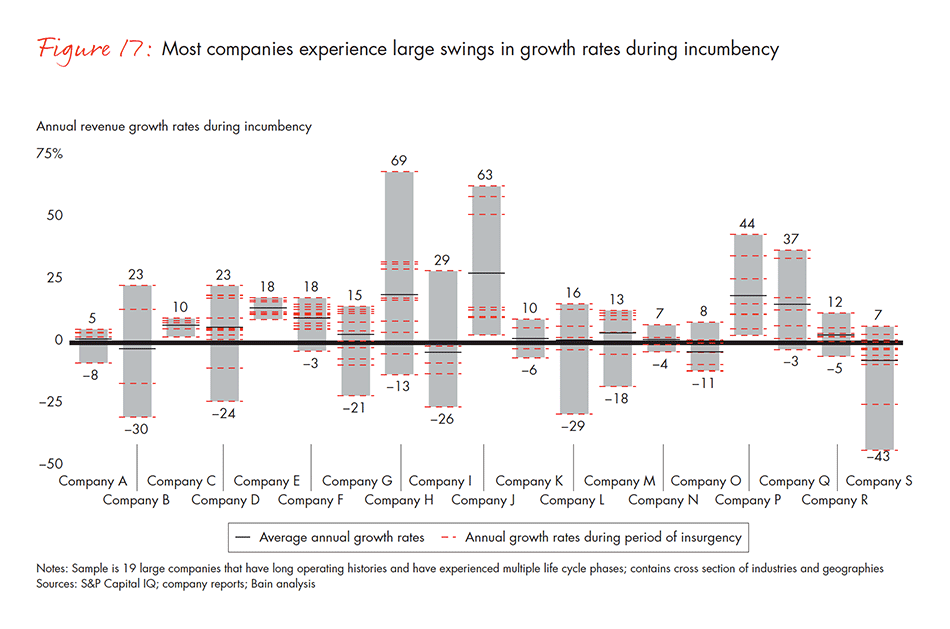
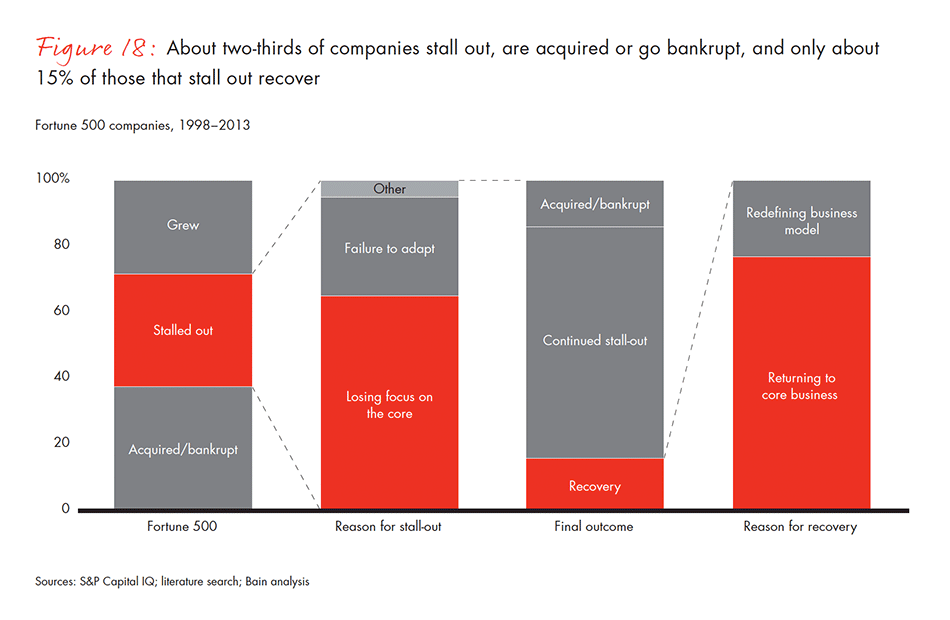
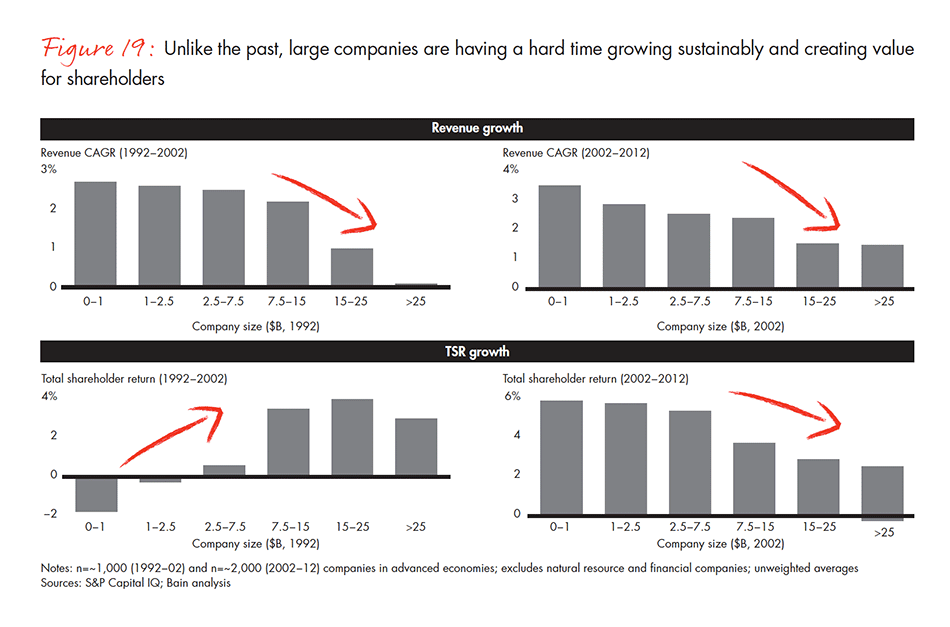
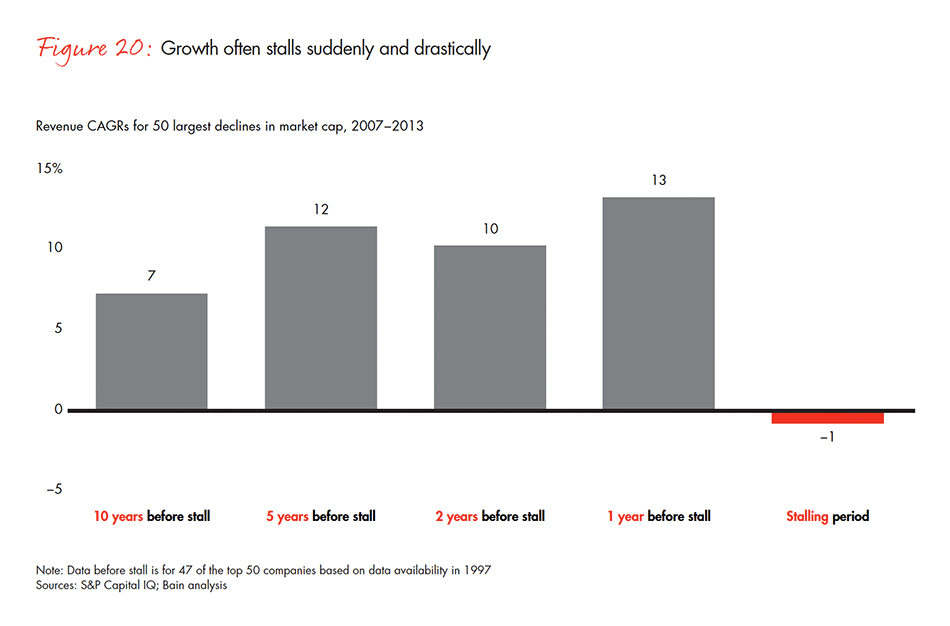
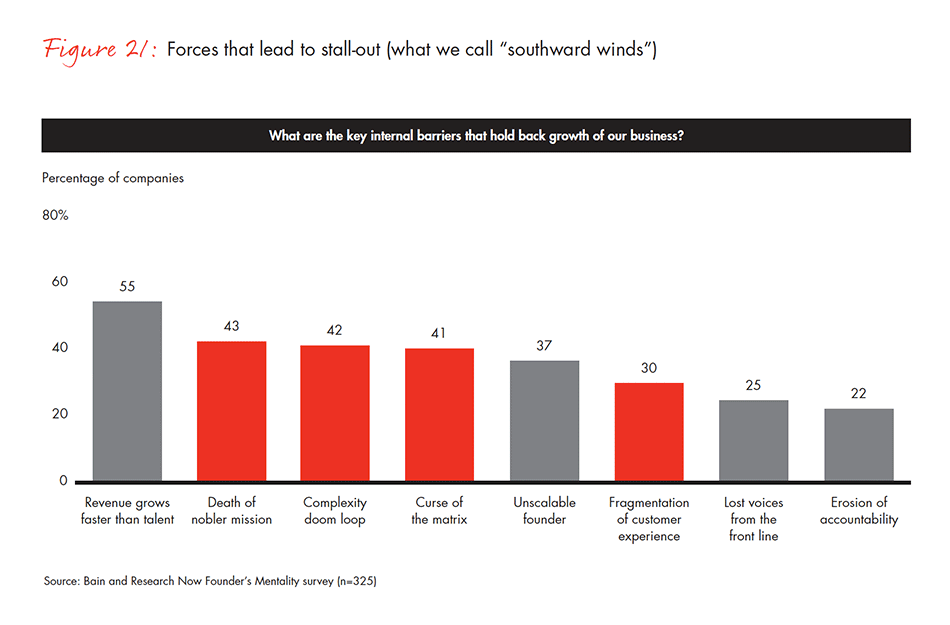
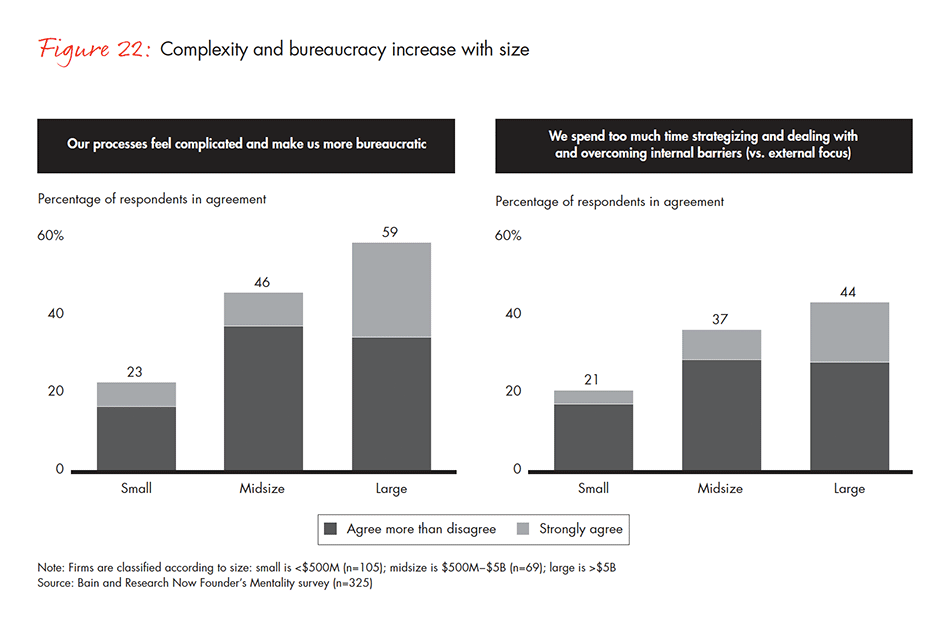
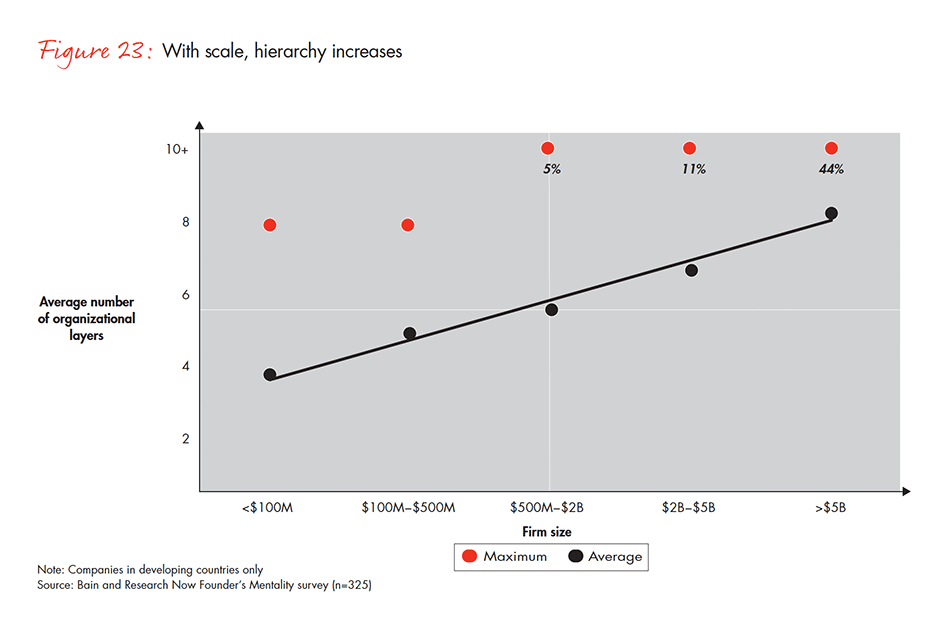
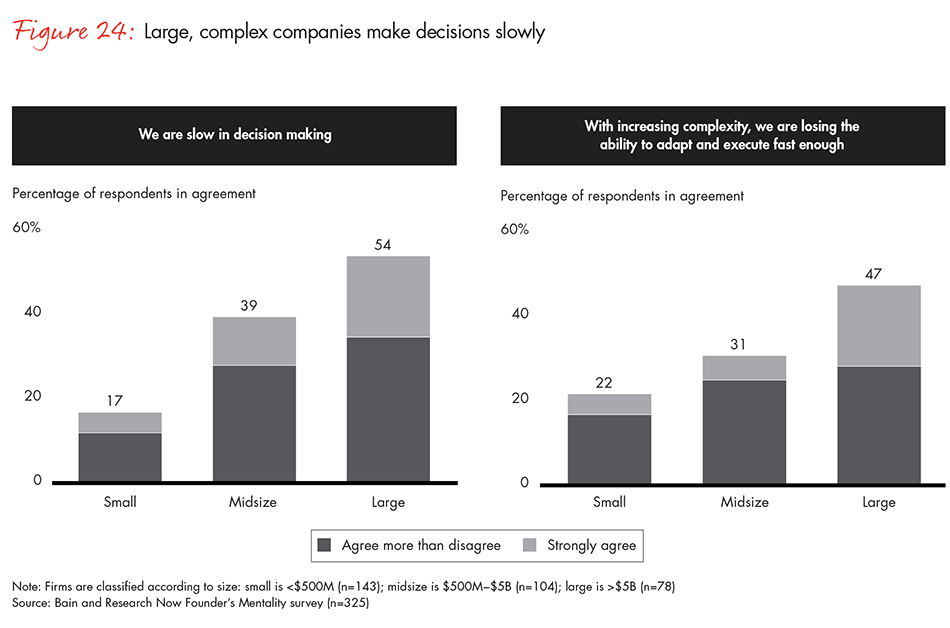
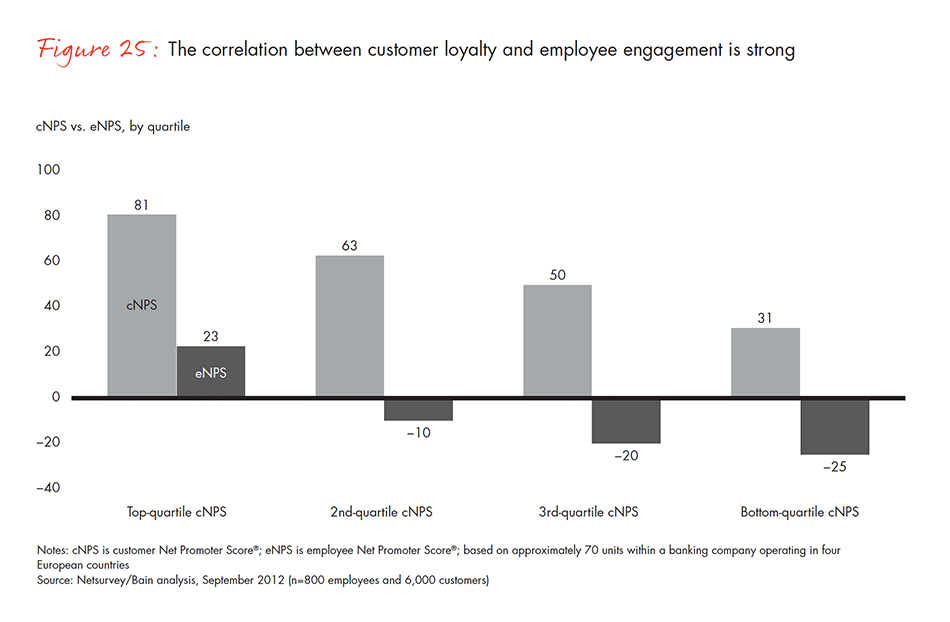
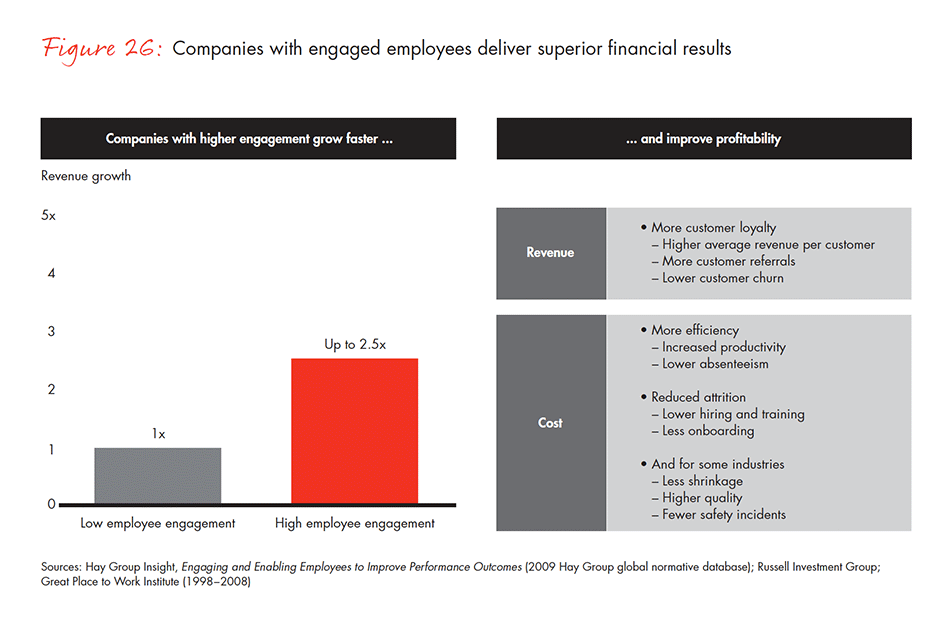
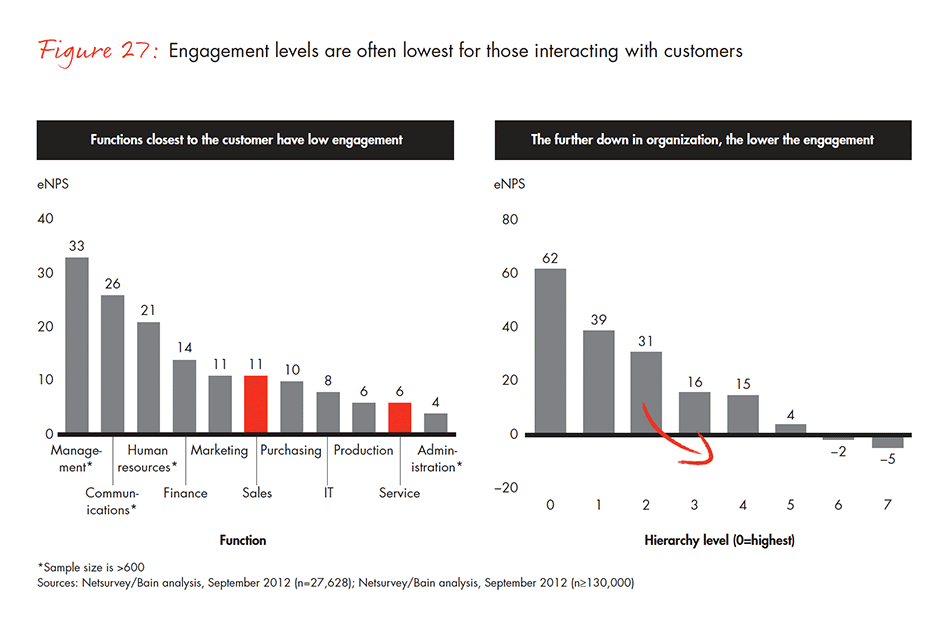
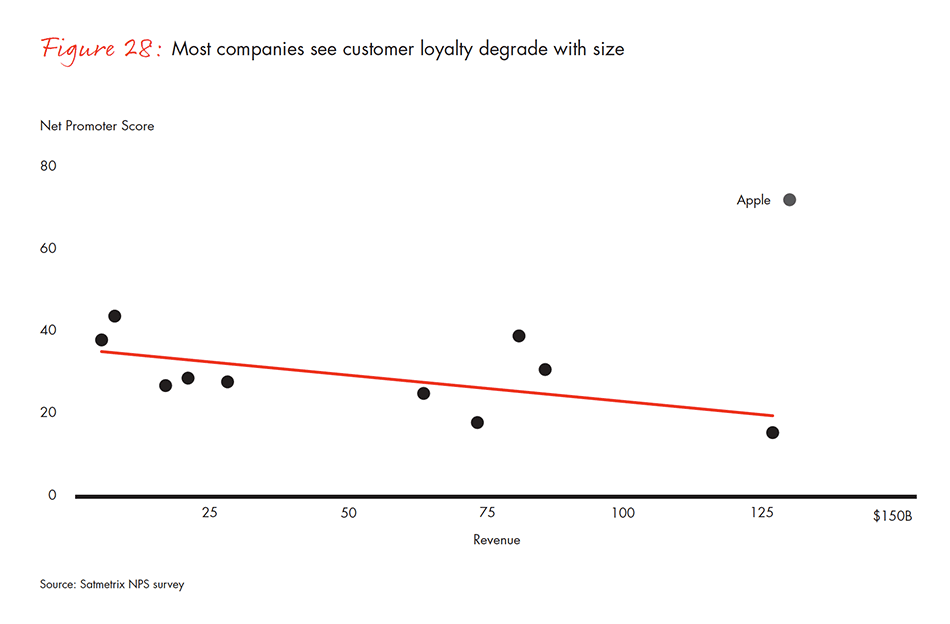
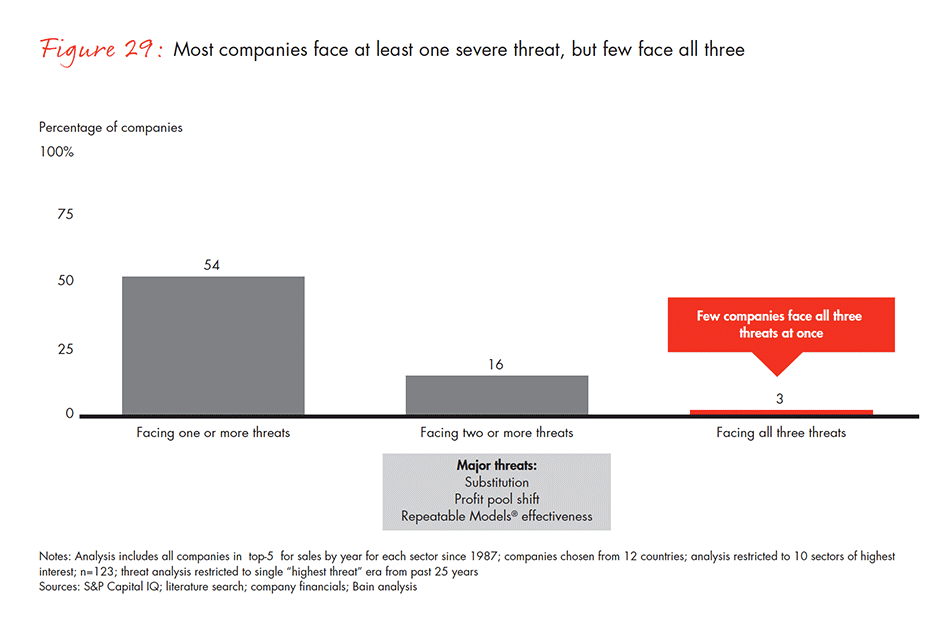
4. The case for renewal
- Firms with low Founder’s Mentality lag behind companies with high Founder’s Mentality when it comes to attracting, retaining and training talent, as well as engaging customers and frontline employees.
- Firms with low Founder’s Mentality are less able to contend with the forces that cause overload and stall-out.
- Firms with high Founder’s Mentality are more externally focused and customer focused.
- Successful transformations recover about three times the value lost during decline.
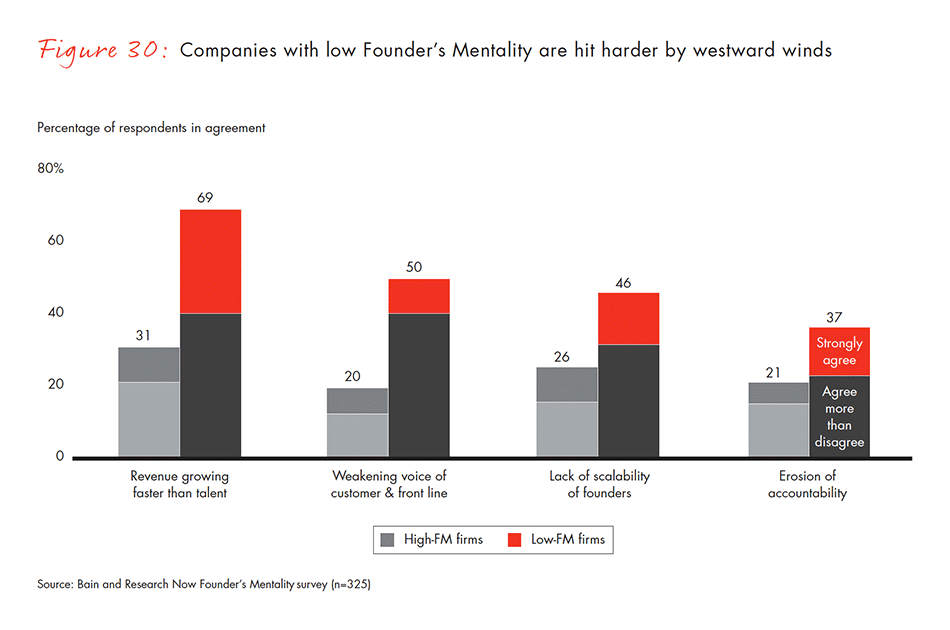
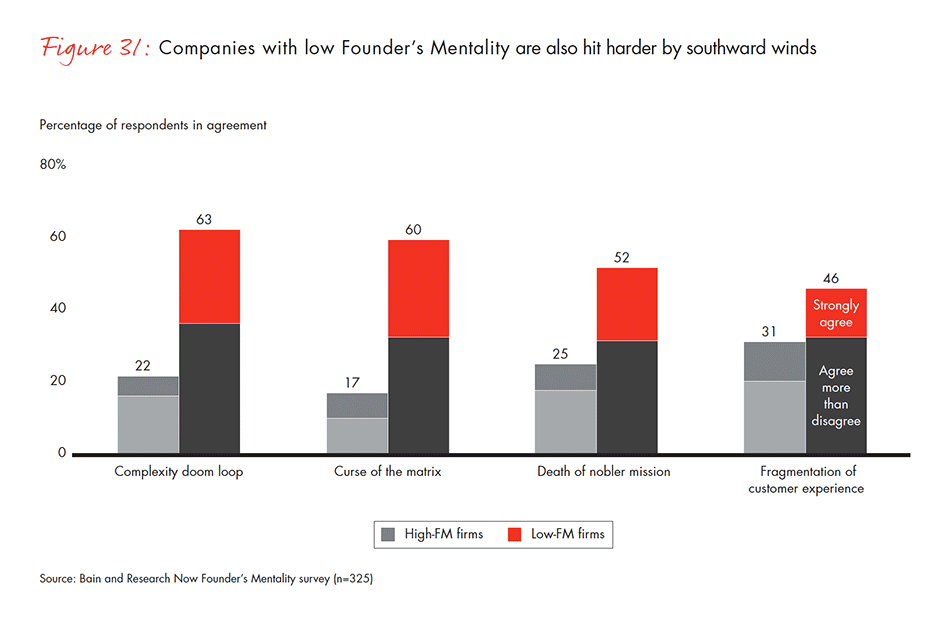
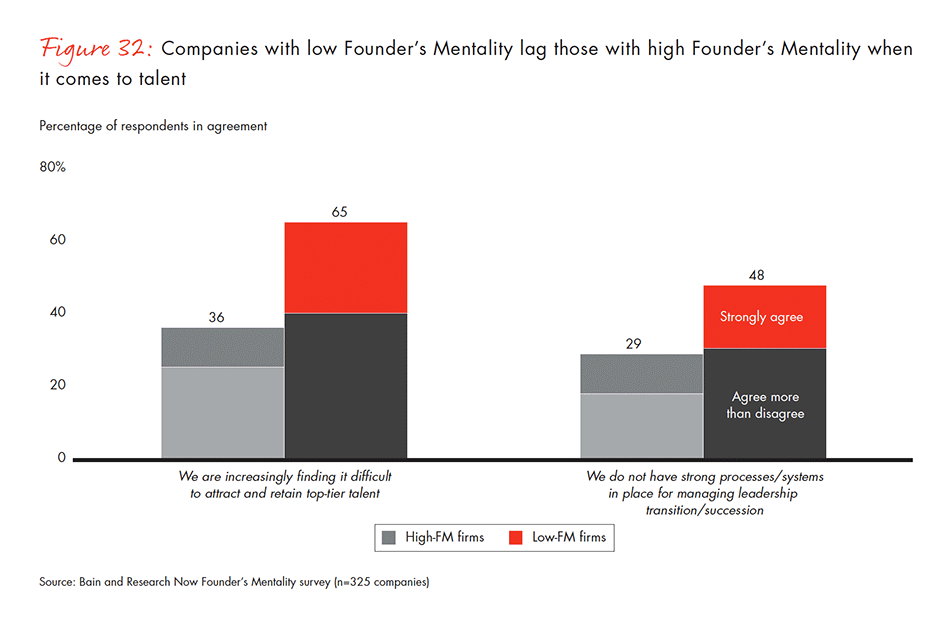
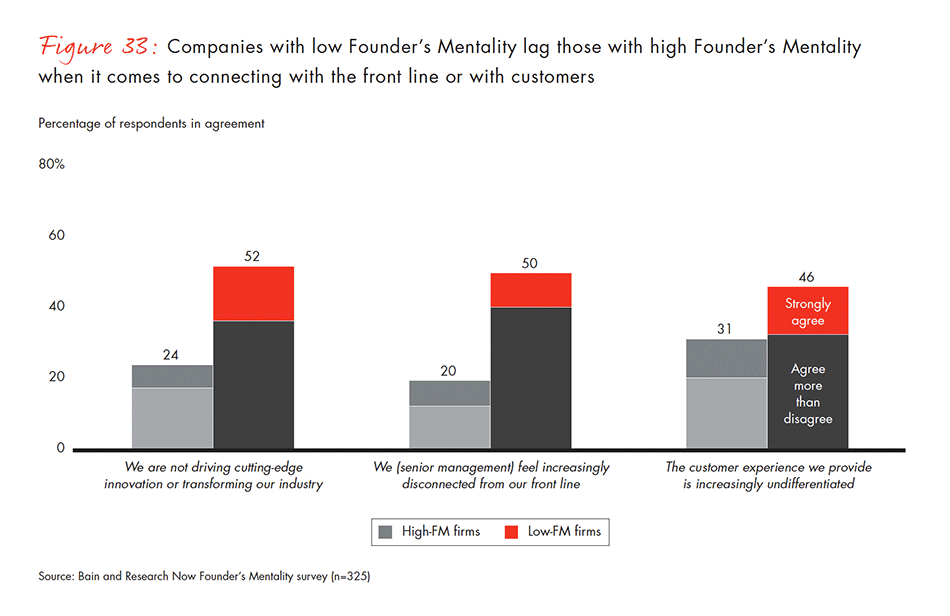
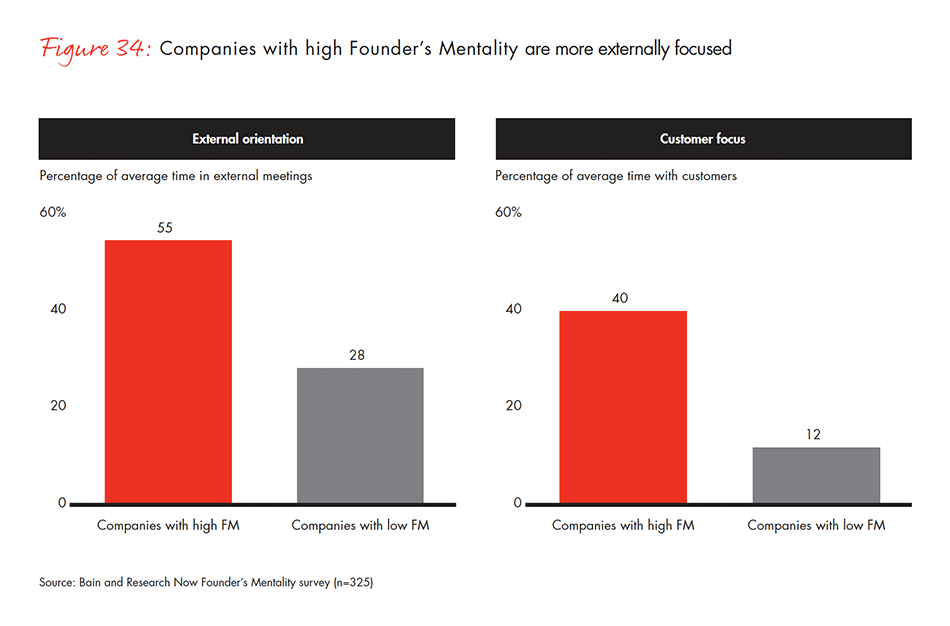
5. Faster growth, faster stall-out
- Companies are growing to scale faster than ever.
- Companies that were young in 2012 grew 1.8 times faster in their first five years than companies that were young in 1992.
- Those same 2012 companies grew 2.2 times faster than their 1992 counterparts in their first 10 years.
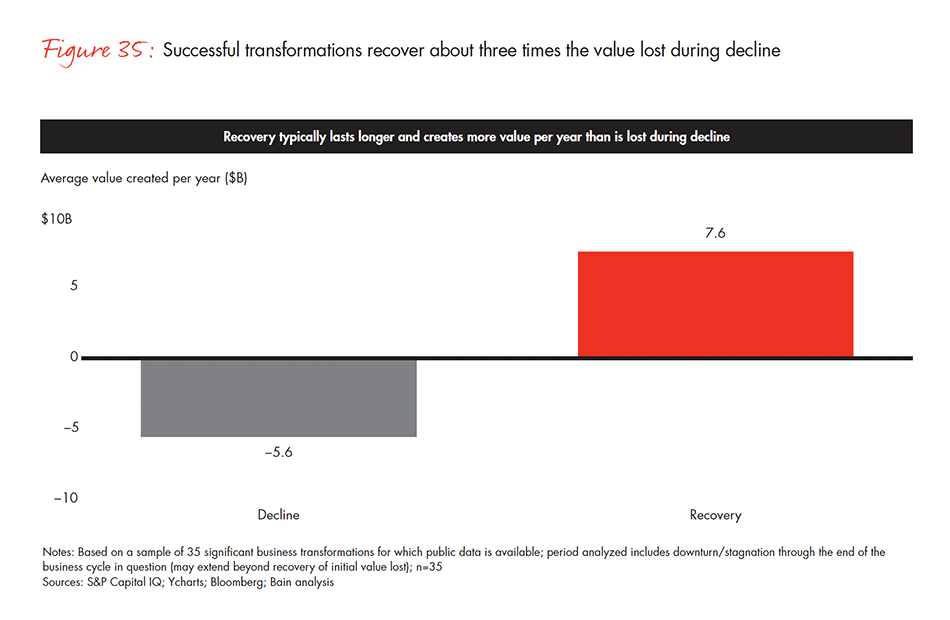
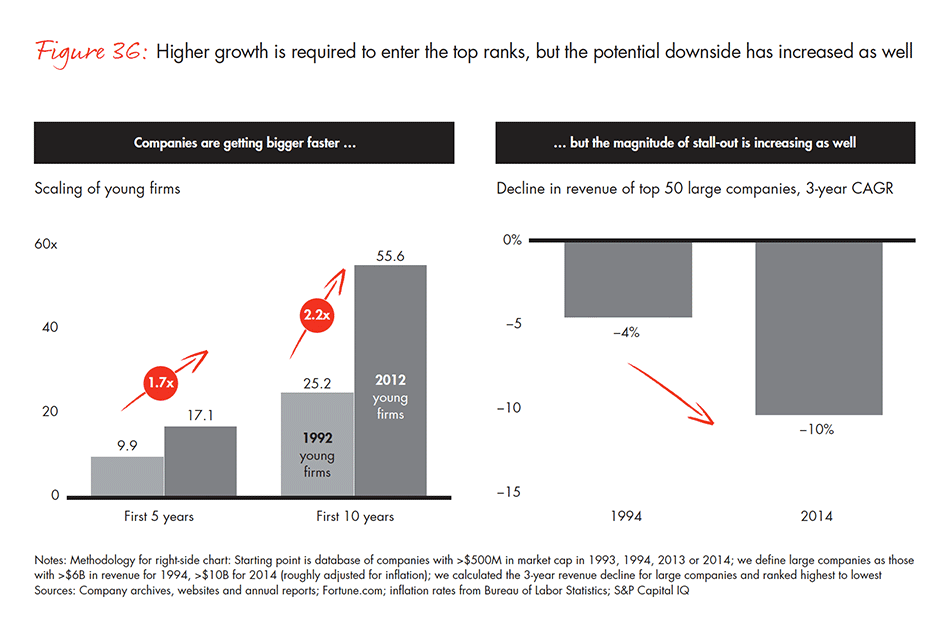
Founder’s Mentality® is a registered trademark of Bain & Company, Inc. Repeatable Models® is a registered trademark of Bain & Company, Inc.
Net Promoter®, Net Promoter System®, Net Promoter Score® and NPS® are registered trademarks of Bain & Company, Inc., Fred Reichheld and Satmetrix Systems, Inc.
Chris Zook is a partner at Bain & Company and has been coleader of the firm’s Global Strategy practice for 20 years. He is based in Boston and Amsterdam, and specializes in helping companies find new sources of profitable growth. James Allen is a partner in Bain’s London office. Coleader of the firm’s Global Strategy practice, he is founder of the Founder’s Mentality 100, a global network of high-growth companies. Zook and Allen are the authors of five best-selling books on strategy, including Profit from the Core.
About our research
- Chris Zook and James Allen, The Founder’s Mentality: How to Overcome the Predictable Crises of Growth, Harvard Business Review Press, June 2016
- Seven sets of discussions around the world with top growth companies, part of a Bain & Company project called the Founder’s Mentality 100 (FM100)
- Interviews with about 100 executives and founders worldwide
- Two global surveys of growth targets and barriers (n=325, n=377)
- Bain Sustained Value Creator Database (n=~8,000 global public companies)
- Analysis of case examples from Bain & Company’s Global Experience Center (GXC) and from outside sources (literature search and books)
- Analysis of performance of Founder’s Mentality companies vs. other companies (macro with S&P 500 companies and micro using a database of 200 company practices)
- Supplementary surveys (e.g., Endeavor Global Entrepreneurs)
- Analysis of value creation at different stages of a company’s life cycle
- Analysis of large-company stall-outs (frequency, recovery, causes, speed)
- Analysis of small-company rates of growth
- International studies of growth and job creation and the role of young companies





































Founder's Mentality
Fast-growing companies can become global leaders without losing the values that helped them succeed. Bain’s research explores how large incumbents can also reignite their growth by recapturing their Founder’s Mentality®.